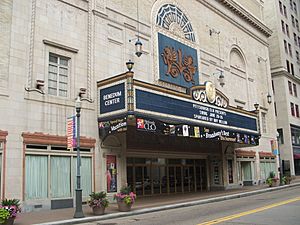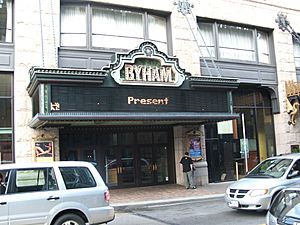Cultural District, Pittsburgh facts for kids
The Cultural District is a lively part of Downtown Pittsburgh. It covers 14 city blocks. This special area is next to the Allegheny River. It is also bordered by Tenth Street, Stanwix Street, and Liberty Avenue.
This district is a hub for arts and entertainment. It has six theaters that host about 1,500 shows every year. You can also find art galleries, restaurants, and shops here. Important places in the district include Allegheny Riverfront Park, the Benedum Center, the Byham Theater, and Heinz Hall. Other key spots are the O'Reilly Theater and the August Wilson Center for African American Culture. The Pittsburgh Creative and Performing Arts School is also located here.
Many big arts groups call this district home. These include the Pittsburgh Ballet Theatre, Pittsburgh Opera, and the Pittsburgh Symphony Orchestra.
Contents
How the Cultural District Started
The idea for the Cultural District came from a man named H. J. Heinz II. People knew him as Jack Heinz. The Pittsburgh Cultural Trust manages the district today. This Trust was created in 1984. Its goal was to make Jack's dream come true. He wanted to turn a run-down area into a vibrant cultural center.
Heinz Hall: From Movie Palace to Concert Hall
One of the first big changes was to the Loew's Penn Theatre. This building was finished in 1927. It was designed by Rapp & Rapp, famous architects for movie theaters. The main lobby was very grand. It had a tall, vaulted ceiling and large columns. There was also a beautiful marble staircase.
In the 1960s, like many old movie theaters, Loew's Penn Theatre faced tough times. More people were watching TV or going to new theaters in the suburbs. The theater closed in 1964 and was almost torn down.
But Jack Heinz and others stepped in to save it. They bought the theater to create a new home for the Pittsburgh Symphony. After a full restoration, this amazing concert hall reopened in 1971. It was renamed Heinz Hall. Today, it can seat 2,676 people. The Pittsburgh Symphony Society owns and runs Heinz Hall.
The Benedum Center: A Grand Transformation
The Pittsburgh Cultural Trust's first major project was restoring another stunning movie palace. This was the Stanley Theater. It opened in 1928 and was the largest theater in Western Pennsylvania. People called it "Pittsburgh's Palace of Amusement."
The Trust spent $43 million to bring it back to its original glory. In 1987, it reopened as the Benedum Center for the Performing Arts. It can now host about 2,885 people. The Pittsburgh Cultural Trust owns and operates the Benedum Center.
The Byham Theater: A Historic Stage
The Byham Theater is another landmark building in Downtown Pittsburgh. It was the second major theater project for the Pittsburgh Cultural Trust. Built in 1903, it was first called the Gayety Theater. It hosted live stage shows and Vaudeville acts. Famous stars like Ethel Barrymore performed there.
In the 1930s, it became a full-time movie theater and was renamed The Fulton. In 1990, the Trust bought it and renovated it. The Byham family of Pittsburgh made a large donation for a 1995 renovation. Since then, it has been known as the Byham Theater. It can seat 1,300 people. The Pittsburgh Cultural Trust owns and operates the Byham Theater.
The Cultural District Today
Today, this 14-block area continues to grow and improve. It has changed from a less desirable area with only two cultural spots to a lively arts neighborhood. Now, it has more than fourteen arts venues. These include the Pittsburgh Creative and Performing Arts School, public parks, and new businesses.
The Pittsburgh Cultural Trust has a complete plan for urban renewal. They improve streets, restore building fronts, and add new cultural facilities. They also create public spaces and art projects.
The Cultural District's transformation is highly praised. It is seen as a great example of how arts can help rebuild a city. Brendan Lemon from The New York Times wrote about how theater helped change Pittsburgh's identity.
The Cultural District is also home to the Pittsburgh Film Office. This group helps bring movie, TV, and commercial productions to the Pittsburgh area. Since 1990, they have helped over 102 film and TV projects. These projects have brought more than $575 million to the region.
Theaters in the Cultural District
- Benedum Center (used to be the Stanley Theater)
- Byham Theater (used to be the Gayety Theater, then the Fulton Theater)
- Harris Theater (used to be Art Cinema)
- Heinz Hall (used to be Loew's Penn Theater)
- O'Reilly Theater (built in 1999)
- The August Wilson Center for African American Culture
- The Cabaret at Theatre Square
- Bricolage Production Company
- Pittsburgh Playwrights Theatre Company
Visual Arts in the Cultural District
- Wood Street Galleries
- Future Tenant
- SPACE
- 707-709 Penn Galleries
- Watercolors Gallery
- ToonSeum
See also
- Theatre in Pittsburgh




